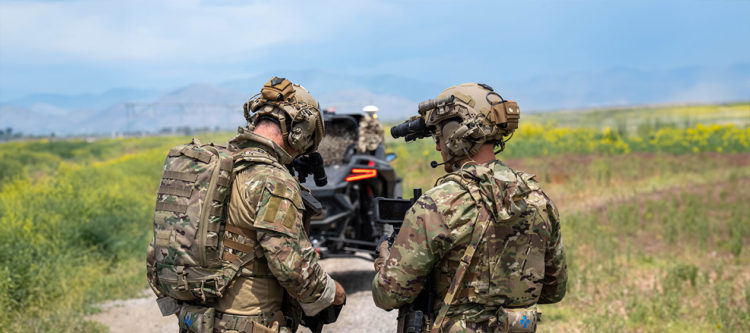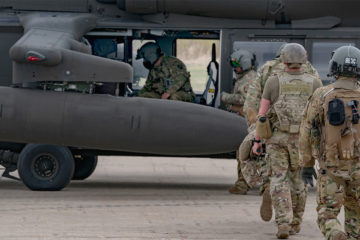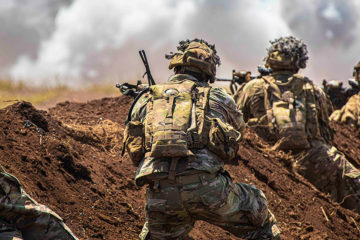Forterra’s goTenna acquisition – paving the way for a new era of autonomous systems and operator safety

On October 9, 2025, Forterra, a leader in autonomous mission systems, announced its acquisition of goTenna, the pioneer of tactical burst networking solutions. This acquisition will further strengthen the existing partnership between the two companies, resulting in the integration of goTenna’s mobile burst networking solutions into Forterra’s autonomous mission ecosystem.
The integration of goTenna into Forterra’s solutions will enhance communication capabilities for military, law enforcement, and emergency response tactical operators by bolstering communication connectivity, particularly in austere environments. This will help keep personnel safe by increasing the effectiveness of autonomous solutions and making tactical operators who accompany them more capable and connected.
To learn more about this exciting new acquisition, The Last Mile sat down with Ari Schuler, the President at goTenna, Andrea Garrity, the Chief Growth Officer at goTenna, and Scott Sanders, the Chief Growth Officer at Forterra.

The Last Mile (TLM): Why did Forterra decide to acquire goTenna? Why was the company and its technologies a good fit for Forterra’s solution portfolio?
Ari Schuler: Forterra is all about deploying autonomous platforms and capabilities in some of the harshest environments on Earth. To date, they’ve been laser-focused on developing and delivering the best autonomous, self-driving capabilities possible for military and law enforcement users.
By integrating goTenna, Forterra is enabling its users to quickly and cost-effectively deploy communications to dismounted individuals who often accompany its autonomous systems in the field, whether that is on the battlefield, at the southern border, or in an emergency response scenario. Also, autonomy requires communication. Having a best-in-class communications capability, like goTenna, makes Forterra’s solutions stronger and more resilient for the tactical operator.
Scott Sanders: I’ve been a user of goTenna’s products in the past. During my time as a Special Operations Team Leader in MARSOC, I relied on goTenna radios in combat, and I thought their solutions were incredible. Since then, I’ve been a fan of their distributed, low-bandwidth, hard-to-detect communications platform.
“…autonomy requires communication. Having a best-in-class communications capability, like goTenna, makes Forterra’s solutions stronger and more resilient for the tactical operator.” –Ari Schuler
As we look at the future of autonomous systems, there will always be a need for high-bandwidth communications platforms, but there’s also an incredible demand for something low-cost and easily deployable. For instance, goTenna’s solutions can be deployed directly by tactical operators or integrated into low-cost munitions and drones. They enable the next generation of autonomous systems with a resilient, low-cost communications platform that’s hard to detect and even harder to jam.
TLM: How does goTenna and its solutions integrate or interoperate with Forterra’s solutions? How will the integration of these solutions benefit the military?
Ari Schuler: The integration of Forterra and goTenna will allow us to bring three vitally important things together. The first are Forterra’s autonomous vehicles, which carry effector payloads and sensors. The second are dismounted users, or tactical operators who execute a mission in collaboration with those autonomous vehicles. The third is a shared infrastructure, meaning a communications relay or remote communications capability that enables law enforcement and military leaders to better command the battlefield.
With these three things, military and law enforcement organizations can effectively circle any location with the right mix of assets needed to accomplish the mission.
Additionally, because goTenna’s solutions are low-visibility and difficult for adversaries to detect, they enable the ability to operate in a contested environment in a way that no other communications stack can.
TLM: That last point you raised about electronic warfare – why is it so important for today’s military operations that communications are difficult to detect and difficult to deny?
Scott Sanders: There’s a time and a place for high-bandwidth communications in the field. I don’t think they will ever be replaced. However, in contested environments, where an adversary is leveraging advanced electronic warfare (EW) capabilities, these operators need to emit the least amount of spectrum possible.
“I can confidently say that this acquisition was about more than the technology… Ultimately, we share a common purpose: ensuring that the men and women on the front lines have the tools they need to succeed, safely and effectively.” –Scott Sanders
The ability to enable an LPI or LPD network enhances a military or law enforcement organization’s ability to meet the challenge posed by future threats. It gives them the ability to operate in extremely complicated and noisy environments and still communicate effectively. goTenna is the only solution truly enabling that capability today.
This is particularly important for today’s military. EW has been abundant in Ukraine, with entire areas of the country that are completely comms denied. That is a considerable concern with autonomous systems – what decisions are being made, with or without a human in the loop? Having access to communications in contested environments ensures there’s a human in the loop whenever possible.
TLM: Aside from the technologies, how do the two companies, goTenna and Forterra, align? Do you anticipate any integration challenges arising from the presence of conflicting or contrasting cultures?
Scott Sanders: That’s a great question, and I can confidently say that this acquisition was about more than the technology. When considering the acquisition of a company, cultural fit and mission alignment are crucial factors. The culture and focus of the company are closely aligned with ours, as both organizations are dedicated to the mission and developing innovative solutions that enhance the safety and effectiveness of tactical operators in the field.
Ultimately, we share a common purpose: ensuring that the men and women on the front lines have the tools they need to succeed, safely and effectively.
Andrea Garrity: That’s completely correct. In our previous interactions, it was clear that both companies had an urgency and desire to move quickly and get capabilities to the edge faster. That commitment to enabling the operator in the field is not something you see every day or in every company.
TLM: Both goTenna and Forterra have existing customers who may be wondering what this acquisition means for them. What impact will the acquisition have on goTenna’s existing customers? What about Forterra’s existing customers?
Ari Schuler: There will be no change to the day-to-day operations at goTenna, and the way we work for and with our government customers will remain the same.
“…the mix of Forterra’s leading autonomy and mission systems, and goTenna’s communications capabilities will protect the warfighter, protect the first responder, and protect the law enforcement officer on the edge.” –Ari Schuler
One of the things we appreciate the most about the Forterra team is their understanding of the government customer and the pace of operations. They understand that any disruption of those operations is unacceptable for military and law enforcement organizations. Because of this understanding, Forterra has been committed to ensuring that goTenna’s operations remain unchanged.
However, in the coming months and years, customers can look forward to new capabilities, increased innovation, and exciting new technologies from the combined goTenna and Forterra teams.
This acquisition will provide goTenna with the resources and ability to drive innovation across goTenna’s portfolio of mobile burst networking solutions, while also enabling the creation of joint product offerings for customers.
Scott Sanders: For our customers, this acquisition means increased access to goTenna’s incredible products. Essentially, our end users will experience a more vertically integrated, seamless communications infrastructure.
Additionally, goTenna’s mobile burst networking solutions will be integrated into our next-generation command, control, and communications suite as a default option, allowing users to leverage them on the platforms they already have. This will make the advanced communications capabilities enabled by goTenna’s solutions more readily available and deployable for existing Forterra customers.
TLM: Moving forward, what do government users and tactical operators have to look forward to as a result of these two companies coming together?
Ari Schuler: What’s most important is that you have two companies with proven track records of deploying actual technologies that benefit the mission. Both companies have been fielding mission-critical technologies for the battlefield, border security operations, and emergency response operations for decades.
“The government has been requesting this from its industry partners for a long time. They’ve been asking us to bring capabilities and full solutions, not just a piece or a component of a complete solution.” –Andrea Garrity
Regardless of whether the mission is a rescue situation in a remote and austere location, or a complicated law enforcement mission with multiple agencies working together, the mix of Forterra’s leading autonomy and mission systems, and goTenna’s communications capabilities will protect the warfighter, protect the first responder, and protect the law enforcement officer on the edge.
We’ll accomplish this by keeping them out of danger with autonomous platforms or equipping them with additional capabilities to keep them connected and safe. Regardless, bringing these two companies together will ultimately save lives.
Scott Sanders: That’s our vision as a company. That’s why we wake up early every morning to work on this problem set. We wish we had these capabilities when we were in military service. During my time as a Marine, we had to devise makeshift communications solutions on the battlefield, often in remote locations.
Today, companies like Forterra and goTenna are developing comprehensive solutions that meet the complete, end-to-end needs and requirements of tactical operators.
Andrea Garrity: The government has been requesting this from its industry partners for a long time. They’ve been asking us to bring capabilities and full solutions, not just a piece or a component of a complete solution. This piecemeal approach has traditionally resulted in operators having to build their solutions in the field, only to discover that the components don’t interoperate. Complete solutions are essential for bringing robust capabilities to the tactical edge.
Ari Schuler: I’d like to add that with Forterra and goTenna, you have two companies that have fielded technologies at scale, and have employees who have done the mission, both in uniform and support roles. Our companies and our employees understand that, when you get down range, it’s a different ballgame.
We have decades of combined experience deploying technology in kinetic environments, including law enforcement operations and emergency response scenarios. This year alone, we’ve been involved in more than half a dozen high-profile law enforcement operations. We know what it takes to accomplish the mission.
We’re excited to work with Forterra to develop amazing technologies and get those technologies into the hands of tactical operators so that we can keep them safe, connected, and out of harm’s way.
To read more about Forterra’s acquisition of goTenna, click HERE.







No Comment